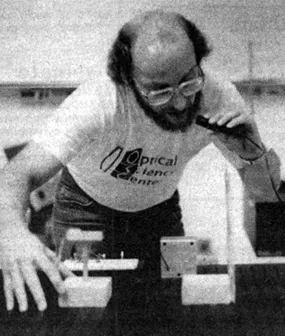Middle School Scattering

The scattering of light makes the sky appear blue, the clouds look white, turns the sun red at sunset and clears a middle school faster than the last bell before summer vacation. This last phenomenon was one that professor Michael Nofziger, aka Dr. Mike, discovered during one of his early outreach events.
Dr. Mike and then-undergraduate student Iwonka Palusinski, Ph.D. 2003, arrived at Marana Middle School in the early 1990s toting the usual materials for some fun optics demonstrations: a variety of lenses, mirrors and fiber optics, and some simple examples of lasers. Things were going according to schedule. They had covered several topics and were coming to their last experiment: a light scattering demonstration using a laser pointer and, up until that day, a couple of chalk-dust-filled erasers. It was basically a mini light show illustrating how the laser’s beam was directed. Typically, they would get some “oohs” and “aahs” as the students saw that light was actually there. That day they got much more.

Dr. Mike, always the quintessential Midwestern gentleman, recognized that most teachers would prefer their classroom not be covered in chalk dust, so he came up with an alternative: Fog in a Can. (Picture the hairspray prop used in the musical “Hairspray.”) So, armed with an aerosol can of fog and his trusting assistant with a laser pointer, he explained the demonstration and aimed the can toward the ceiling.
Immediately after Dr. Mike pressed the nozzle, even before Iwonka had time to ready the laser pointer, the fire alarm sounded and the lights went off in the entire school. Twenty-some sets of eyes looked up to see one well-placed smoke detector before filing out of the classroom to join the rest of their schoolmates on the playground to wait for the fire trucks to arrive.
Dr. Mike has been quoted to say, "Good teaching is more than just having students learn equations. Good teaching is really about motivating students to use their creative and critical thinking skills." I suspect that, on that particular day, the students and Dr. Mike learned a very creative and critical optics lesson: Smoke detectors, like motion detectors, are optical sensors that use a continuous beam of light. When the beam is broken by a vapor, the alarm is triggered. The detector cannot tell the difference between real smoke and fake smoke resulting in flashing lights and red fire trucks!
